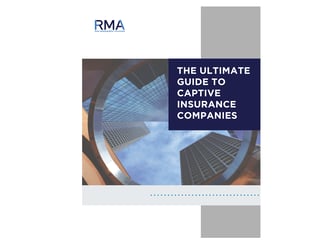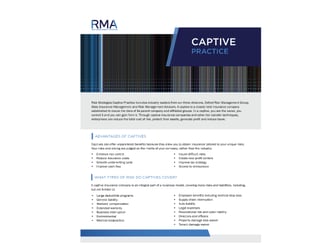Definition and Purpose of a Feasibility Study
A feasibility study is a comprehensive analysis and evaluation of a proposed project or business venture to determine whether it is viable, practical, and achievable. It involves assessing the strengths, weaknesses, opportunities, and threats of the project and analyzing various factors that could affect its success. The purpose of a feasibility study is to provide decision-makers with valuable insights and recommendations to make informed choices regarding the project's implementation.
In the context of captive insurance, a feasibility study plays a crucial role in assessing the viability and potential benefits of establishing a captive insurance company. Captive insurance involves creating a subsidiary company to provide insurance coverage to the parent company and its affiliates. Before setting up a captive, conducting a feasibility study is essential to evaluate its feasibility and determine if it aligns with the company's risk management objectives.
Importance of Feasibility Study in Captive Insurance
A feasibility study is vital for captive insurance because it helps companies assess the potential benefits, risks, and costs associated with establishing a captive. Here are some reasons why a feasibility study is crucial in the captive insurance industry:
- Risk Assessment: Conducting a feasibility study allows companies to evaluate their risk profile and determine if captive insurance is an effective risk management strategy. The study assesses the types and frequency of risks the company faces, analyzes claims data, and identifies areas where a captive can provide cost-effective coverage.
- Financial Analysis: A feasibility study includes a thorough financial analysis to determine the financial implications of setting up a captive. It assesses the potential cost savings, tax benefits, and return on investment that a captive could provide. This analysis helps companies make informed decisions about whether a captive is financially viable and aligns with their long-term financial goals.
- Regulatory and Legal Considerations: Captive insurance involves navigating complex regulatory and legal frameworks. A feasibility study examines the legal and regulatory requirements of establishing a captive and assesses the company's ability to comply. It also identifies any potential legal and compliance risks associated with captive insurance and provides recommendations to mitigate them.
- Market Analysis: A feasibility study includes a thorough analysis of the captive insurance market to identify market trends, competitive landscape, and potential opportunities. It also provides insights into pricing and underwriting considerations.
- Stakeholder Engagement: Conducting a feasibility study involves engaging key stakeholders, such as company executives, risk management teams, legal advisors, and insurance experts. This collaborative approach ensures that all perspectives are considered, and any concerns or challenges are addressed before proceeding with establishing a captive. Stakeholder engagement also helps in gaining buy-in and support for the captive insurance initiative.
- Decision-Making: Ultimately, the feasibility study provides decision-makers with comprehensive information and recommendations to make an informed decision about whether to move forward with establishing a captive. It helps companies weigh the potential benefits against the risks and costs, ensuring that the decision aligns with the company's strategic objectives and risk appetite.
Key Components of a Feasibility Study
A feasibility study is a crucial step in the process of establishing a captive insurance company. It helps organizations evaluate whether a captive insurance arrangement is a viable option for their risk management needs. Here are the key components of a feasibility study:
Risk Assessment and Underwriting Analysis
A critical component of a feasibility study is conducting a comprehensive risk assessment and underwriting analysis. This involves identifying the specific risks that the captive insurance company will cover and assessing their likelihood and potential impact. It also involves analyzing the underwriting standards and guidelines for accepting risks, setting premiums, and managing claims.
Financial Analysis and Projections
A feasibility study must include a thorough financial analysis and projection to assess the financial viability of a captive insurance company. This analysis involves estimating the initial capital requirements, ongoing operating expenses, and potential revenue streams. It also includes projecting the financial performance of the captive insurance company over a specified period, considering factors such as premiums, claims, and investment returns.
Key financial considerations in a feasibility study:
- Start-up costs: Analyze the initial investment required to establish the captive insurance company, including capitalization, licensing, and infrastructure expenses.
- Revenue projections: Estimate the potential revenue streams based on premiums, investment returns, and other income sources.
- Expense analysis: Identify and analyze the operating costs associated with running the captive insurance company, including underwriting fees, reinsurance costs, claims administration, and regulatory compliance expenses.
- Profitability assessment: Evaluate the profitability of the captive insurance company under various scenarios, considering factors such as loss ratios, investment performance, and overhead costs.
Regulatory and Legal Considerations
Compliance with regulatory and legal requirements is crucial for a captive insurance company's success. A feasibility study should evaluate the regulatory environment and legal considerations related to establishing and operating a captive insurance company. This includes understanding the licensing requirements, reporting obligations, and governance standards imposed by regulatory authorities. It also involves assessing any potential legal risks and liabilities that the captive insurance company may face.
Operational and Management Evaluation
The operational and management evaluation is a vital component of a feasibility study as it assesses the organization's capacity to establish and effectively manage a captive insurance company. This evaluation includes examining the organization's internal capabilities, such as its expertise in risk management, underwriting, claims handling, and financial management. It also involves evaluating the governance structure, organizational processes, and technology infrastructure required to operate a successful captive insurance company. Many companies opt to outsource many of these functions to third-party firms with the oversight of a captive management firm.
By conducting a comprehensive feasibility study that addresses these key components, organizations can make informed decisions about whether to proceed with establishing a captive insurance company.
Key considerations in decision-making and strategy development:
- Risk management: Assess the risk appetite and risk mitigation strategies associated with the captive insurance company, including underwriting guidelines, claims management processes, and reinsurance arrangements.
- Growth strategies: Determine the growth potential and expansion opportunities for the captive insurance company, such as expanding product offerings.
- Resource allocation: Analyze the resource requirements, including personnel, technology, and infrastructure, to support the captive insurance company's operations and growth.
- Exit strategy: Consider exit options and timelines in case the captive insurance company does not meet the expected targets or if the strategic direction changes.
Best Practices for Conducting a Feasibility Study
Key steps and considerations for a comprehensive and effective study
When it comes to establishing a captive insurance company, conducting a feasibility study is crucial. A feasibility study helps determine whether the formation of a captive insurance company is a viable and beneficial option for an organization. Here are some key steps and considerations to ensure a comprehensive and effective feasibility study:
- Define Objectives: Clearly define the objectives of the study, including the specific goals and desired outcomes. This will help guide the entire process and ensure that the study remains focused and relevant.
- Gather Data: Collect and analyze relevant data from various sources. This may include data on the organization's insurance needs, current insurance program, claims history, financials, industry benchmarks, and regulatory requirements. The more comprehensive the data collected, the more accurate the conclusions of the study will be.
- Assess Risk Profile: Evaluate the organization's risk profile to determine if it aligns with the benefits of a captive insurance structure. Consider factors such as the frequency and severity of claims, risk appetite, risk management practices, and insurance market conditions. This assessment will help determine whether a captive insurance company can effectively meet the organization's risk management objectives.
- Financial Analysis: Conduct a thorough financial analysis to assess the potential costs and benefits of establishing a captive insurance company. This may include evaluating the captive's ability to generate underwriting profits, estimating premium savings compared to traditional insurance, projecting cash flows, and assessing the potential tax implications. A financial analysis will provide insights into the financial viability of the captive insurance structure.
- Regulatory and Legal Considerations: Understand the regulatory and legal requirements associated with forming and operating a captive insurance company. Consider factors such as licensing, domicile selection, capital requirements, governance, and compliance obligations. It is essential to ensure that the captive insurance structure complies with all applicable laws and regulations.
- Stakeholder Engagement: Engage key stakeholders throughout the feasibility study process. This may include senior management, risk managers, finance professionals, legal advisors, and external consultants. Collaborating with stakeholders will help gather valuable insights, address concerns, and ensure the feasibility study considers all relevant perspectives.
- Risk Mitigation Strategies: Identify and evaluate risk mitigation strategies that can be implemented within the captive insurance structure. This may include exploring alternative risk financing mechanisms, implementing loss control and risk management programs, and leveraging reinsurance solutions. Effective risk mitigation strategies will contribute to the overall success and sustainability of the captive insurance company.
- Comprehensive Report: Compile all the findings, analysis, and recommendations into a comprehensive feasibility study report. The report should present a clear and concise overview of the study's findings, conclusions, and recommendations. It should serve as a valuable resource for decision-makers and stakeholders involved in the establishment of a captive insurance company.
Conducting a comprehensive and effective feasibility study is crucial for organizations considering the establishment of a captive insurance company. It provides a solid foundation for informed decision-making and ensures that the captive insurance structure aligns with the organization's risk management and financial objectives. With proper planning and execution, a well-conducted feasibility study can pave the way for a successful captive insurance program.
Explore
- Solutions
- Captive Insurance
- Captive Insurance Overview
- What is Captive Insurance?
- Definition of Captive Insurance
- Types of Captive Insurance
- Typical Structures of a Captive Insurance Program
- Why Form a Captive Insurance Company?
- Captive Insurance Utilization and Value
- Evaluating a Captive Insurance Program
- How to Setup a Captive Insurance Company
- Operating a Captive Insurance Company
- Captive Insurance Operating Costs
- Retaining Risk vs. Financing Risk
- Risk Distribution Through Captive Insurance
- Taxation of a Captive Insurance Company
- Captive Insurance Domiciles
- News and Insights
- About Us
Practice Leaders

Captive Practice Leader, Managing Director

Captive Practice Leader, Managing Director
Max Jong is the Captive Practice Leader and Managing Director at Risk Management Advisors, an alternative risk and captive management firm. Max began his career at Northwestern Mutual in 1994 after graduating from UCLA. Over 12 years, he built a successful financial services practice while heading up an office overseeing 50 professionals in Los Angeles and Irvine, California. The office was perennially one of the top producing organizations in the Northwestern Mutual system.
Max joined his partners at Risk Management Advisors in 2007 as he began to work with more sophisticated mid-market business owners. RMA specializes in the design, formation, and management of captive insurance companies. There’s also an emphasis on self-funded group benefits as well as other creative alternative risk management strategies. The firm assists business owners in better managing their risks without jeopardizing their balance sheets. In 2019, he headed up a merger with Risk Strategies, a Top 10 private national specialty insurance brokerage and consulting firm. Since then, he was appointed as the Captive Practice Leader to oversee the growth and development of the organization.
For five years, Max served as an Independent Director for Fiat Lux Risk and Insurance Company, one of the largest and most sophisticated captive insurance companies. Fiat Lux was established by the University of California Regents to better manage the broad risks of the University of California system.
Max has also been a lifelong supporter of Big Brothers Big Sisters of Greater Los Angeles. He initially volunteered to be a mentor in 1995 and is currently mentoring his second "Little." Max was asked to join the Board of Directors in 2000 and eventually served as their Board Chair. After 20+ years as an active board member, he continues to support the organization by serving as a Trustee.
He is married to Alice, and they’re raising two young children, Hunter and Hayden. Max and Alice are happily married despite her irreparable mistake of going to USC. He loves to travel, golf, and is a hopeful Lakers fan.
Resources








